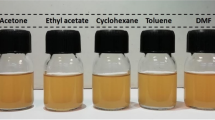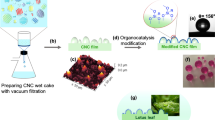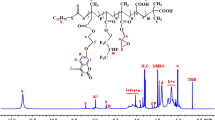Abstract
Hydrophobic cellulose nanocrystals (CNs) have been prepared by grafting isocyanate-terminated castor oil, a kind of natural vegetable oil, onto their surface. The existence of castor oil component in the modified cellulose nanocrystals was verified by Fourier transform infrared spectroscopy, solid-state 13C NMR spectra and X-ray photoelectron spectroscopy. At the same time, X-ray diffraction and transmission electron micrographs further proved that the crystalline structure and large aspect ratio of cellulose nanocrystals were essentially preserved after chemical grafting. Furthermore, the surface of modified cellulose nanocrystals appeared to be hydrophobic as indicated by contact angle measurements. The value of the polar component of surface energy decreased from 21.5 mJ/m2 to almost zero via grafting castor oil. These novel hydrophobic castor oil-grafted cellulose nanocrystals appear as valuable alternatives to formulate bionanocomposites with non-polar polymers for optimized performances.








Similar content being viewed by others
References
Atalla RH, Gast JC, Sindorf DW, Bartuska VJ, Maciel GE (1980) Carbon-13 NMR spectra of cellulose polymorphs. J Am Chem Soc 102:3249–3251. doi:https://doi.org/10.1021/ja00529a063
Bondeson D, Oksman K (2007) Polylactic acid/cellulose whisker nanocomposites modified by polyvinyl alcohol. Comp Part A—Appl S 38: 2486–2492. doi: https://doi.org/10.1016/j.compositesa.2007.08.001
Buschle-Diller G, Zeronian SH (1992) Enhancing the reactivity and strength of cotton fibers. J App Poly Sci 45:967–979. doi:https://doi.org/10.1002/app.1992.070450604
Butun S, Ince FG, Erdugan H, Sahiner N (2011) One-step fabrication of biocompatible carboxymethyl cellulose polymeric particles for drug delivery systems. Carbohyd Polym 86:636–643. doi:https://doi.org/10.1016/j.carbpol.2011.05.001
Cao X, Habibi Y, Lucia L (2009) One-pot polymerization surface grafting, and processing of waterborne polyurethane-cellulose nanocrystal nanocomposites. J Mater Chem 19:7137–7145. doi:https://doi.org/10.1039/B910517D
Capadona J, Shanmuganathan K, Tyler D, Rowan S, Weder C (2008) Stimuli-responsive polymer nanocomposites inspired by the sea cucumber dermis. Science 319:1370–1374. doi:https://doi.org/10.1126/science.1153307
Chen G, Dufresne A, Huang J, Chang P (2009) A novel thermoformable bionanocomposite based on cellulose nanocrystal-graft-poly(ε-caprolactone). Macromol Mate Eng 294:59–67. doi:https://doi.org/10.1002/mame.200800261
Chiappone A, Nair J, Gerbaldi C, Jabbour L, Bongiovanni R, Zeno E, Beneventi D, Penazzi N (2011) Microfibrillated cellulose as reinforcement for Li-ion battery polymer electrolytes with excellent mechanical stability. J Power Sources 196:10280–10288. doi:https://doi.org/10.1016/j.jpowsour.2011.07.015
Cho M, Park B (2011) Tensile and thermal properties of nanocellulose-reinforced poly(vinyl alcohol) nanocomposites. J Ind Eng Chem 17:36–40. doi:https://doi.org/10.1016/j.jiec.2010.10.006
Eichhorn SJ, Baillie CA, Zafeiropoulos N et al (2001) Review current international research into cellulose fibres and composites. J Mater Sci 36: 2107–2131. doi:https://doi.org/10.1023/A:1017512029696
Favier V, Chanzy H, Cavaille J (1995) Polymer nanocomposites reinforced by cellulose whiskers. Macromolecules 28:6365–6367. doi:https://doi.org/10.1021/ma00122a053
García-González C, Alnaief M, Smirnova I (2011) Polysaccharide-based aerogels-Promising biodegradable carriers for drug delivery systems. Carbohyd Polym 86:1425–1438. doi:https://doi.org/10.1016/j.carbpol.2011.06.066
Habibi Y, Lucia LA, Rojas OJ (2010) Cellulose nanocrystals: chemistry, self-assembly, and applications. Chem Rev 110:3479–3500. doi:https://doi.org/10.1021/cr900339w
Labet M, Thielemans W, Dufresne A (2007) Polymer grafting onto starch nanocrystals. Biomacromolecules 8:2916–2927. doi:https://doi.org/10.1021/bm700468f
Lin N, Chen G, Huang J, Dufresne A, Chang R (2009) Effects of polymer-grafted natural nanocrystals on the structure and mechanical properties of poly(lactic acid): a case of cellulose whisker-graft-polycaprolactone. J Appl Polym Sci 113:3417–3425. doi:https://doi.org/10.1002/app.30308
Lin N, Huang J, Chang R, Feng J, Yu J (2011) Surface acetylation of cellulose nanocrystal and its reinforcing function in poly(lactic acid). Carbohyd Polym 83:1834–1842. doi:https://doi.org/10.1016/j.carbpol.2010.10.047
Lin N, Huang J, Duresne A (2012) Preparation, properties and applications of polysaccharide nanocrystals in advanced functional nanomaterials: a review. Nanoscale 4:3274–3294. doi:https://doi.org/10.1039/C2NR30260H
Ljungberg N, Cavaille J, Heux L (2006) Nanocomposties of isotactic polypropylene reinforced with rod-like cellulose whiskers. Polymer 47:6285–6292. doi:https://doi.org/10.1016/j.polymer.2006.07.013
Lu Y, Weng L, Cao X (2006) Morphological, thermal and mechanical properties of ramie crystallites—reinforced plasticized starch biocomposites. Carbohyd Polym 63:198–204. doi:https://doi.org/10.1016/j.carbpol.2005.08.027
Ly EB, Bras J, Sadocco P, Belgacem MN, Dufresne A, Thielemans W (2010) Surface functionalization of cellulose by grafting oligoether chains. Mater Chem Phys 120:438–445. doi:https://doi.org/10.1016/j.matchemphys.2009.11.032
Owens DK, Wendt RC (1969) Estimation of the surface free energy of polymer. J Appl Polymer Sci 13:1741–1747. doi:https://doi.org/10.1002/app.1969.070130815
Paquet O, Krouit M, Bras J, Thielemans W, Belgacem MN (2010) Surface modification of cellulose by PCL grafts. Acta Mater 58:792–801. doi:https://doi.org/10.1016/j.actamat.2009.09.057
Pei A, Malho J, Ruokolainen J, Zhou Q, Berglund L (2011) Strong nanocomposite reinforcement effects in polyurethane elastomer with low volume fraction of cellulose nanocrystals. Macromolecules 44:4422–4427. doi:https://doi.org/10.1021/ma200318k
Peng B, Dhar N, Liu H, Tam K (2011) Chemistry and applications of nanocrystalline cellulose and its derivatives: a nanotechnology perspective. The Can J Chem Eng 89:1191–1206. doi:https://doi.org/10.1002/cjce.20554
Roy D, Semsarilar M, Guthrie JT, Perrier S (2009) Cellulose modification by polymer grafting: a review. Chem Soc Rev 38:2046–2064. doi:https://doi.org/10.1039/b808639g
Shanmuganathan K, Capadona J, Rowan S, Weder C (2010) Biomimetic mechanically adaptive nanocomposites. Prog Polym Sci 35:212–222. doi:https://doi.org/10.1016/j.progpolymsci.2009.10.005
Shopsowitz K, Qi H, Hamad WY, MacLachlan MJ (2010) Free-standing mesoporous silica films with tunable chiral nematic structures. Nature 468:422–425. doi:https://doi.org/10.1038/nature09540
Siqueira G, Bras J, Dufresne A (2009) Cellulose whiskers versus microfibrils: influence of the nature of nanoparticle and its surface functionalization on the thermal and mechanical properties of nanocomposites. Biomacromolecules 10:425–432. doi:https://doi.org/10.1021/bm801193d
Siqueira G, Bras J, Dufresne A (2010) New process of chemical grafting of cellulose nanoparticles with a long chain isocyanate. Langmuir 26:402–411. doi:https://doi.org/10.1021/la9028595
Supova M, Martynkova GS, Barabaszova K (2011) Effect of nanofillers dispersion in polymer matrices: a review. Sci Adv Mater 3:1–25. doi:https://doi.org/10.1166/sam.2011.1136
Wada M, Heux L, Sugiyama J (2004) Polymorphism of cellulose I family: reinvestigation of cellulose IVI. Biomacromolecules 5:1385–1391. doi:https://doi.org/10.1021/bm035357
Wang Y, Cao X, Zhang L (2006) Effects of cellulose whiskers on properties of soy protein thermoplastics. Macromol Biosci 6:524–531. doi:https://doi.org/10.1002/mabi.200600034
Williamson K, Masters KM (1994) Macroscale and microscale organic experiments, 2nd edn. Lexington, Mass, DC, p 40
Zhang X, Huang J, Chang P, Li J, Chen Y, Wang D, Yu J, Chen J (2010) Structure and properties of polysaccharide nanocrystal-doped supramolecular hydrogels based on cyclodextrin inclusion. Polymer 51:4398–4407. doi:https://doi.org/10.1016/j.polymer.2010.07.025
Acknowledgments
This work is financially supported by Supporting Project of New Century Excellent Talents of Ministry of Education of China (NCET-11-0686); National Natural Science Foundation of China (21172269); Fundamental Research Funds for the Central Universities (Self-Determined and Innovative Research Funds of WUT 2012-Ia-006); ecoENERGY Innovation Initiative of Canada; and Program of Energy Research and Development (PERD) of Canada.
Author information
Authors and Affiliations
Corresponding authors
Rights and permissions
About this article
Cite this article
Shang, W., Huang, J., Luo, H. et al. Hydrophobic modification of cellulose nanocrystal via covalently grafting of castor oil. Cellulose 20, 179–190 (2013). https://doi.org/10.1007/s10570-012-9795-0
Received:
Accepted:
Published:
Issue Date:
DOI: https://doi.org/10.1007/s10570-012-9795-0




